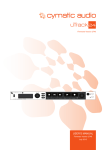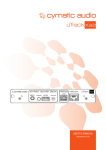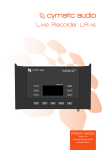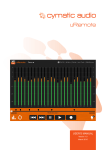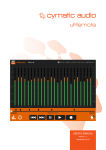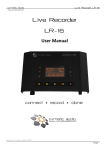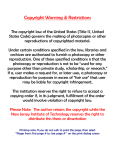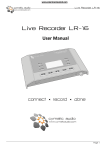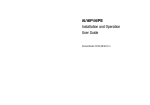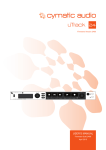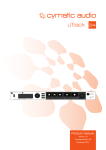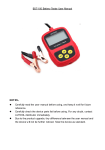Download Live Player LP-16 Product Manual
Transcript
User Manual LP-16 October 2015 Table of Contents Table of Contents ........................................................................................................................................................... 2 1. SAFETY PRECAUTIONS ...................................................................................................................................... 4 1.1. AC adapter ................................................................................................................................................... 4 1.2. Environment ................................................................................................................................................. 4 1.3. Handling ....................................................................................................................................................... 4 1.4. Connecting cables and input and output jacks ............................................................................................. 4 1.5. Alterations..................................................................................................................................................... 4 1.6. Volume ......................................................................................................................................................... 4 2. USAGE PRECAUTIONS ....................................................................................................................................... 5 2.1. Electrical interference ................................................................................................................................... 5 2.2. Cleaning ....................................................................................................................................................... 5 3. LIMITED WARRANTY ........................................................................................................................................... 5 4. INTRODUCTION ................................................................................................................................................... 6 5. WHAT’S IN THE BOX ........................................................................................................................................... 6 6. LP-16 CONNECTIONS AND USER INTERFACE ................................................................................................. 7 6.1. Front Panel ................................................................................................................................................... 7 6.2. Rear Panel.................................................................................................................................................... 8 6.3. Top Panel ..................................................................................................................................................... 9 7. MODES OF OPERATION ................................................................................................................................... 10 7.1. Multi-Track Mode ........................................................................................................................................ 10 7.2. Stereo Mode ............................................................................................................................................... 10 7.3. USB Interface Mode ................................................................................................................................... 10 8. SIGNAL FLOW .................................................................................................................................................... 11 9. LP-16 FOLDER STRUCTURE ............................................................................................................................ 12 10. LP-16 TRANSPORT BEHAVIOR ........................................................................................................................ 12 10.1. Using the Stop Button ................................................................................................................................. 12 10.2. Playing back from an offset position ........................................................................................................... 12 10.3. Accessing a Playlist .................................................................................................................................... 12 11. WORKING WITH USB MEDIA ............................................................................................................................ 12 11.1. Test failed: Wrong file system ..................................................................................................................... 13 11.2. Test failed: Disk error.................................................................................................................................. 13 12. MULTI-TRACK (MT) MODE OPERATIONS AND MENUS ................................................................................. 14 12.1. Multitrack Mode Home Screen ................................................................................................................... 14 12.2. Multitrack Mode Menus............................................................................................................................... 15 12.2.1. Playback Mode .................................................................................................................................. 15 12.2.2. Select Playlist..................................................................................................................................... 15 12.2.3. MIDI Settings ..................................................................................................................................... 16 12.2.4. Outputs .............................................................................................................................................. 16 12.2.5. Foot Switch settings ........................................................................................................................... 16 12.2.6. Display settings .................................................................................................................................. 17 User Manual LP-16 October 2015 Table of Contents 2 12.2.7. 13. Format USB Device ........................................................................................................................... 17 STEREO (ST) MODE OPERATIONS AND MENUS ........................................................................................... 18 13.1. Stereo Mode Screen ................................................................................................................................... 18 13.2. Stereo Mode Menus ................................................................................................................................... 19 14. 13.2.1. Playback Mode .................................................................................................................................. 19 13.2.2. Play-out Channels.............................................................................................................................. 19 CONNECTING THE LP-16 TO AN AUDIO MIXER ............................................................................................. 20 14.1. Connecting LP-16 to a Mixer with Unbalanced Line Inputs ........................................................................ 20 14.2. Connecting the LP-16 to a Mixer with Balanced Line Inputs....................................................................... 20 15. USB INTERFACE MODE .................................................................................................................................... 21 15.1. Using the LP-16 as an Audio Interface with Microsoft Windows ................................................................. 22 15.1.1. Minimum System Requirements ........................................................................................................ 22 15.1.2. WDM and ASIO Driver Installation ..................................................................................................... 22 15.2. LP-16 Mixer / Control Panel for PC ............................................................................................................ 22 15.2.1. Mixer View ......................................................................................................................................... 22 15.2.2. Settings View: Synchronization Tab ................................................................................................... 25 15.2.3. Settings View: Buffers Tab ................................................................................................................. 26 15.2.4. Settings View: Input Channels Tab .................................................................................................... 27 15.2.5. Settings View: Output Channels Tab ................................................................................................. 28 15.2.6. Settings View: About Tab ................................................................................................................... 29 15.3. Using the LP-16 as an Audio Interface with OS X ...................................................................................... 30 15.3.1. Minimum System Requirements ........................................................................................................ 30 15.3.2. Driver Installation ............................................................................................................................... 30 15.4. Using the LP-16 as an Audio Interface with an Apple® iPad® ................................................................... 30 15.4.1. Minimum System requirements.......................................................................................................... 30 15.4.2. Driver Installation ............................................................................................................................... 30 16. UPDATING THE FIRMWARE ON YOUR LP-16 ................................................................................................. 30 17. TROUBLESHOOTING ........................................................................................................................................ 31 17.1. Standalone Player Mode ............................................................................................................................ 31 17.2. USB Audio Interface Mode ......................................................................................................................... 31 18. SPECIFICATIONS .............................................................................................................................................. 32 19. Legal Disclaimer .................................................................................................................................................. 32 User Manual LP-16 October 2015 Table of Contents 3 1. SAFETY PRECAUTIONS 1.1. 1.2. AC adapter Be sure to use only the supplied 12 V DC, 1000 mA AC adapter, which is equipped with a “center-positive” plug. The use of an adapter other than the specified type may damage the unit and could pose a safety hazard. Connect the AC adapter only to an AC outlet that supplies the rated voltage required by the adapter. When disconnecting the AC adapter from the AC outlet, always grasp the adapter itself and do not pull at the cable. During lightning or when not using the unit for an extended period, disconnect the AC adapter from the AC outlet. Environment To prevent the risk of fire, electric shock or malfunction, avoid using your Live Player LP-16 in environments where it will be exposed to: 1.3. 1.4. Extreme temperatures Heat sources Excessive humidity or moisture Excessive dust or sand Excessive vibration or shock Handling Never place objects filled with liquids on the LP-16, as this can cause electric shock. Do not place an open flame source, such as a lighted candle, on the LP-16 since this can cause fire. The LP-16 is a precision instrument. Do not exert undue pressure on the keys and other controls. Also take care not to drop the unit, and do not subject it to shock or excessive pressure. Take care that no foreign objects (coins, pins etc.) or liquids can enter the unit. Connecting cables and input and output jacks Always turn off the power to the LP-16 and all other equipment before connecting or disconnecting the power source. Make sure to disconnect all connection cables and the power cord before moving the LP-16. 1.5. Alterations Do not open the case of the LP-16, or attempt to modify the product in any way. Doing so will void the warranty. There are no serviceable parts inside the unit. 1.6. Volume Do not use the headphone output of the LP-16 at a loud volume for a long time since this can cause hearing impairment User Manual LP-16 October 2015 SAFETY PRECAUTIONS 4 2. USAGE PRECAUTIONS 2.1. Electrical interference For safety considerations, the LP-16 has been designed to provide maximum protection against the emission of electromagnetic radiation from inside the device, and protection from external interference. However, equipment that is very susceptible to interference or that emits powerful electromagnetic waves should not be placed near the LP-16, as the possibility of interference cannot be ruled out entirely. With any type of digital control device, the LP-16 included, electromagnetic interference can cause malfunctioning and can corrupt or destroy data. Care should be taken to minimize the risk of damage. 2.2. Cleaning Use a soft, dry cloth to clean the LP-16. If necessary, slightly moisten the cloth. Do not use abrasive cleanser, wax, or solvents (such as paint thinner or cleaning alcohol), since these may dull the finish or damage the surface. 3. LIMITED WARRANTY For the applicable warranty terms and conditions and additional information on Cymatic Audio’s Limited Warranty, please see complete details online at www.cymaticaudio.com/warranty CERTIFICATIONS This product complies with the European Union Council Directives and Standards relating to Directive 2004/108/EC for Electromagnetic compatibility (EMC) and Low Voltage Directive 2006/95/EC This product is compliant with the EU Directive 2011/65/EU for the Restriction of the use of Certain Hazardous Substances in Electrical and Electronic Equipment. No lead (Pb), cadmium (Cd), mercury (Hg), hexavalent chromium (Cr+6), PBB or PBDE is intentionally added to this device. Any traces of impurities of these substances contained in the parts are below the RoHS specified threshold levels. This equipment has been tested and found to comply with the requirements of 47 CFR of PART 15 limit for radiation and conduction emission relating to FCC rules Part 15B: 2010. A NOTE ABOUT DISPOSAL: This product must be disposed in accordance with the local recycling regulations. The crossed out wheeled bin symbol informs you that the product should not be disposed of along with municipal waste and invites you to use the appropriate separate take-back systems licensed for the recycling of electrical and electronic equipment (EEE). User Manual LP-16 October 2015 USAGE PRECAUTIONS 5 4. INTRODUCTION Cymatic Audio Live Player LP-16 is an easy to use direct from USB player that can play back 16-tracks of audio along with a MIDI file. It can also be used as 18-output, 2-input USB audio interface for PC, Mac® and iPad®. The LP-16 works as a dedicated multi-track player for live performances, while sparing users the hassles of using a laptop and computer audio interface in a live environment. The LP-16 audio tracks can be connected directly into the line inputs of a live sound mixer. These tracks can be individually mixed alongside the audio from live performers to augment their performance. Used in connection with a Windows PC, Mac® or iPad®, the LP-16 also serves as an 18-output/ 2-input USB audio interface. With a large number of outputs, the individual tracks of a multi-track DAW session can easily be connected to the individual inputs of an analog studio mixer, perfect for analog summing and mixing “out of the box”, imparting classic analog flavor to your next mix session. The LP-16 User Manual contains in-depth details of your Live Player’s features and functionality which include: Direct from USB hard drive multi-track playback (16 tracks at 44.1/48kHz and 16/24 bit) MIDI I/O with synchronized Standard MIDI File player functionality 16 unbalanced analog 1/4” tip-sleeve outputs 1/8” Stereo Line level input¨ Front panel ¼” headphone output with dedicated level control Zero latency hardware input monitoring (USB Interface Mode) 2-input / 18-output USB audio interface, 24 bit/44.1/48 kHz USB Class Compliant Mac® OS-X® compatible: Core Audio plug and play drivers Windows® PC compatible (Windows XP, Vista, 7 & 8 32-bit/64-bit) WDM and ASIO® drivers. IPad® compatible: Plug and play. USB adapter required including Apple® Lightning to USB Camera Adapter Apple® USB Camera Connection Kit Foot Switch connector for hands free playback/pausing of track playback Creation and editing of songs and playlist files offline, using Cymatic’s uTool software 5. WHAT’S IN THE BOX LP-16 player AC/DC power adapter and power cable USB cable Quick Start Guide User Manual LP-16 October 2015 INTRODUCTION 6 6. LP-16 CONNECTIONS AND USER INTERFACE 6.1. Front Panel 1 3 2 4 5 6 1. USB Storage Connector Attach a USB thumb drive or USB hard drive to this connector, to playback songs direct from USB. 2. MIDI input The MIDI input receives incoming MIDI messages, and can also be configured as a MIDI thru using the MIDI settings menu. 3. MIDI Output The MIDI output connector can output the MIDI data from Standard MIDI Files (SMF) synchronously with a multitrack song. With this capability, the LP-16 can trigger external MIDI hardware such as MIDI synthesizers or MIDI-enabled lighting controllers. 4. Foot Switch Connector The footswitch connector allows connection of a standard on/off foot pedal, which can be configured to start play or to play and pause the current song. 5. Headphone Out The headphone connector outputs a stereo signal, which works as follows: • In MT mode, it outputs a mono mix of the 16 tracks • In ST mode, it outputs the stereo file currently being played back • In USB mode, it outputs the stereo DAW signal 6. Headphone Volume This knob allows volume adjustment of the front-panel headphone output. ! For more details of the above connectors’ functions, refer to the “Menus” section of this user’s manual User Manual LP-16 October 2015 LP-16 CONNECTIONS AND USER INTERFACE 7 6.2. Rear Panel 5 1 2 3 4 1. Mono Line-Level Output Connectors These unbalanced connectors each output a separate mono audio track, sourced from the multi-track song being played back. 2. Stereo 3.5mm Input This connector is used as a 2-channel, unbalanced line-level input when the LP-16 is operating in USB interface mode. 3. USB Device Connector This female USB connector is used to attach the LP-16 to an OS X or Windows computer, or an iOS device, allowing the LP-16 to act as a 2-input, 18-output audio interface. 4. External Power Supply Connector Connect the included external power supply to this connector. 5. Power Switch Use this switch to turn power on/off to the LP-16 User Manual LP-16 October 2015 LP-16 CONNECTIONS AND USER INTERFACE 8 6.3. Top Panel The top panel buttons perform the following functions, depending on which of the three modes is currently active: 1 9 2 10 3 11 4 1 2 3 4 5 6 7 8 9 10 11 Multitrack Mode Switch to stereo mode Show multitrack mode menu Go back to previous screen Increment playback offset Decrement playback offset Pause/Stop playback Start playback Show folder contents screen Selection up Select Selection down 5 6 7 Stereo Mode Switch to multitrack mode Show stereo mode menu Go back to previous screen Increment playback offset Decrement playback offset Pause/Stop playback Start playback Show folder contents screen Selection up Select Selection down 8 USB Interface Mode No Function Show input settings menu Go back to previous screen No Function No Function No Function No Function No Function Selection up Select Selection down In addition, four separate key combinations are also available that perform the following functions: Stop & Play Toggles between playlist mode and normal player mode the LP-16 Long press Stop Send midi all notes off in multi-track player mode User Manual LP-16 October 2015 LP-16 CONNECTIONS AND USER INTERFACE 9 7. MODES OF OPERATION The LP-16 offers three different modes of operation, depending on your specific needs: 7.1. Multi-Track Mode This mode, hereby abbreviated as “MT Mode”, is the main operational mode of the LP-16. In MT mode, the unit can play back up to 16 separate tracks of audio along with a MIDI file. Each audio track is output to a separate physical ¼” output connector on the rear panel of the unit. MIDI is played on the MIDI port on the front panel of LP-16. 7.2. Stereo Mode The LP-16 also offers a “stereo player mode”, hereby referred to as “ST Mode”. This mode is ideal for playback of stereo audio songs, such as pre-show, post-show, and break music. The stereo songs can be configured to be output from a specific pair of outputs on the rear panel. NOTE: The LP-16 only plays back stereo files in the “.wav” format. NOTE: The mode button can be used to toggle between Multitrack mode and stereo mode. Cymatic Audio provides a software application called uTool. Songs and Playlist projects (both multitrack and stereo) can be created in uTool and exported to a USB drive. The USB drive can then be plugged into the LP-16 for playback. uTool software and user manual are available at www.cymaticaudio.com/downloads. 7.3. USB Interface Mode In USB Interface mode, the LP-16 acts as a 2-input, 18-output audio interface for OS X, Windows, and iOS. For more details, please refer to the section titled “USB Interface Mode”. The interface mode is not available when the LP-16 is being used in standalone for playback with the USB drive. User Manual LP-16 October 2015 MODES OF OPERATION 10 8. SIGNAL FLOW The LP-16 contains 16 separate line-level outputs, which are sent out on 16 separate mono, unbalanced line-level outputs. In MT mode, the LP-16 also contains an internal digital mixer that provides a mono mix down of the 16 separate audio streams, mixed together at unity gain. This internal mix is sent out of the front-panel headphone output. When operating as a USB computer audio interface, the stereo line input allows recording of 2 incoming channels to the DAW, while 18 separate DAW output channels can be sent to the LR-16 (16 to the rearpanel outputs and an additional stereo channels sent to the headphone output). User Manual LP-16 October 2015 SIGNAL FLOW 11 9. LP-16 FOLDER STRUCTURE The uTool software exports the songs and playlist projects into specific folders on the USB drive. All the multitrack songs are exported to the “Recording” folder and all the Multitrack playlists are exported to “Recording/#PLAYLISTS” folder. All the stereo songs are exported to the “Music” folder and all the stereo playlists are exported to “Music/#PLAYLISTS” folder. 10. LP-16 TRANSPORT BEHAVIOR 10.1. Using the Stop Button When the LP-16 is currently playing back a song: The first press of the stop button pauses the playback. The second press stops the playback. 10.2. Playing back from an offset position To start playback of a song from an offset position: Press the skip forward or skip backward button to start the playback offset overlay. Use the same buttons to increment or decrement the start offset. Long press helps to jump with higher granularity. After a desired offset is reached, press the play button to start playback from the selected offset position. The offset overlay disappears after playback starts, Press the back button to remove the offset overlay. 10.3. Accessing a Playlist To navigate to a playlist folder, use one of the three following methods: 11. Press the “folder” button; the folder active for the current mode opens up. You can then navigate to the playlist folder. Press the stop and play buttons at the same time to toggle between normal playback mode and playlist mode. Press the “menu” button and then select the “Go to Playlist” menu option WORKING WITH USB MEDIA Connect the LP-16 to its external power supply and turn it on. After the brief display of start-up screen, you will see the following screen: Plug in a USB hard drive or USB thumb drive into the USB storage connector on the front of the LP-16. If the LP-16 determines that the storage device is suitable for playback, a new screen will appear for a few seconds, displaying the amount of free space available on the attached drive After displaying this information for a few seconds, the LP-16 display will switch to the playback “home screen”. NOTE: We recommend the use of USB hard drives instead of USB thumb drives because the USB hard drives traditionally tend to offer a more reliable and predictable read speed than USB thumb drives User Manual LP-16 October 2015 LP-16 FOLDER STRUCTURE 12 11.1. Test failed: Wrong file system If the inserted drive is not formatted in the required FAT32 format, the LP-16 will display an error message. Follow the instructions on screen to format the USB drive. Please keep in mind that formatting the attached USB drive will erase all data currently residing on the drive. 11.2. Test failed: Disk error If the inserted drive is defective the screen will give a “Disk Error” User Manual LP-16 October 2015 WORKING WITH USB MEDIA 13 12. MULTI-TRACK (MT) MODE OPERATIONS AND MENUS 12.1. Multitrack Mode Home Screen After the attached USB drive has been successfully tested, the LP-16’s screen will display the MT mode “home screen”. Single Playback Screen 1 2 3 4 Playlist Screen 5 4 6 7 5 6 11 12 9 8 10 1. LP-16 Mode Shows the currently selected playback mode for the LP-16: Multitrack (MT), Stereo (ST), or USB (USB). When the LP-16 is in USB interface mode, the status message will display “PC” or “MAC” ¨ 2. Playback offset overlay Playback offset overlay can be used to play the song from an offset. Use Skip forward and Skip backward buttons to choose the offset and then the Play button to start playing from the offset. 3. Playback Status This icon shows the current state of the playback transport (play/stop/pause). 4. Playback Mode Icon This icon displays the playback mode. Playback mode for MT is explained in detail in the section 12.2.1. 5. Remaining time This number represents the remaining playback time of the currently playing song. 6. Active Song Position/Active Playlist Name Displays the position of the active song inside the folder. In playlist screen, displays the name of the playlist. 7. Active song name Displays the name of the currently active song in single mode. 8. Signal Level Meters (-30dB / -3dB / 0dB) This group of meters displays the approximate signal strength of the audio tracks that are playing back. 9. MIDI Input Indicator Light This circle flashes in time with the data stream of any incoming MIDI signals that are feeding the MIDI input connector. 10. MIDI Output Indicator Light This circle flashes in time with the data stream of any outgoing MIDI signals that are sent out of the MIDI output connector. User Manual LP-16 October 2015 MULTI-TRACK (MT) MODE OPERATIONS AND MENUS 14 11. Next Song Icon This icon indicates how the next song will play back relative to the currently playing song: There will be no pause between the current and the next song The next song will pause until play / footswitch is pressed The next song will play after seconds specified in playlist. Can be overruled by play button / footswitch 12. Next Song Name in Playlist This line displays the name of the next song in the playlist, which will play when the current song is completed. 12.2. Multitrack Mode Menus Pressing the Menu Button while in multitrack mode will take you to the Multitrack Mode Menu. Use the Up/Down buttons, to navigate to the desired menu setting. Use the Select button to choose the settings. Use Up/Down to modify values and Select to confirm the changes. Back button can be used to go one level back without changing the parameters. 12.2.1. Playback Mode This screen allows you to select between the two playback modes available in MT mode: Playlist Mode: In this mode, the LP-16 will play back files in the order that has been set up in the playlist. To make a playlist, use the uTool software. Single Mode: In this mode, any MT song residing in the currently selected folder can be chosen. Playback will play only the single selected song and then stop. 12.2.2. Select Playlist This screen allows you to select a playlist to load into memory. User Manual LP-16 October 2015 MULTI-TRACK (MT) MODE OPERATIONS AND MENUS 15 Use the up and down buttons to scroll to the desired playlist and select button to choose the playlist. 12.2.3. MIDI Settings This screen allows adjustment of various setting related to the MIDI input and output connectors. MIDI Thru: Use this menu to toggle a “MIDI Thru” function on/off for the front panel MIDI output. When MIDI through is activated, all MIDI messages coming into the LP-16 will be merged with the currently playing MIDI file (if one is being played back) and then routed to the LP- 16’s MIDI output. If MIDI through is turned off, this merge activity does not occur MIDI Offset: Adjust this setting to provide an offset (delay) between the start time of a loaded standard MIDI file, and the start time of the associated song. This setting allows you to fine-tune the synchronization timing between the MIDI file and the triggered audio. Send All Notes Off: Select this menu to issue an “all notes off” out of the LP-16’s MIDI output, message to a connected MIDI device, useful if any “stuck notes” occur on a connected MIDI playback device. To issue the command immediately, long press the Stop button in any state. 12.2.4. Outputs Every multitrack song can have mixer fader settings for the headphone outputs (using uTool). The 16 line outputs of LP-16 can be chosen to be pre or post fader. The appropriate option can be chosen from outputs settings. Choose pre-fader when you do not want the mixer fader settings to affect your 16 line outputs. 12.2.5. Foot Switch settings The LP-16 can use a standard ¼” equipped footswitch to perform various functions. The foot switch settings screen allows you to adjust what specific actions occur when you press the attached foot switch. Type: Adjust the “type” setting to tell the LP-16 if you are using a “normally open” or “normally closed” type footswitch. Consult your footswitch’s documentation to determine which type you have. Function: Adjust this setting to configure what specific function the footswitch will perform, when it is pressed Play: Pressing the footswitch mimics the top panel “play” button. Play and Pause: Pressing the footswitch will begin playback. A second press of the footswitch will pause playback, and a third press will un-pause the playback. User Manual LP-16 October 2015 MULTI-TRACK (MT) MODE OPERATIONS AND MENUS 16 12.2.6. Display settings This screen allows you to adjust the LCD display’s contrast, as well as its brightness, in order to ensure optimal readability at different viewing angles. 12.2.7. Format USB Device The format function can be used to format an attached hard drive or thumb drive that is connected to the Live Player. This operation can be useful in the following scenarios: The attached drive has not passed the LP-16’s drive test, because it is not currently formatted in the required FAT-32 disk format The attached drive has been previously formatted in the correct FAT-32 format, but has not had its data blocks optimized properly by the computer it was formatted on, resulting in a failure of the LP-16 disk test. In these cases, formatting the drive on the LP-16 may allow the disk to pass, since the LP-16 will format the attached disk with the required optimal settings. ! User Manual LP-16 October 2015 All data as well as all partitions on the thumb or hard drive will be deleted when the format function is used! MULTI-TRACK (MT) MODE OPERATIONS AND MENUS 17 13. STEREO (ST) MODE OPERATIONS AND MENUS 13.1. Stereo Mode Screen Pressing the mode button when in MT mode switches the LP-16 into stereo mode. The stereo mode screen has a different layout compare to MT mode. Other Modes 1 2 3 4 Playlist Mode 4 5 5 8 6 9 10 7 1. LP-16 Mode This icon will display “ST” to show that the LP-16 is currently operating in Stereo mode. 2. Playback offset overlay Playback offset overlay can be used to play the song from an offset. Use Skip forward and Skip backward buttons to choose the offset and then the Play button to start playing from the offset. 3. Playback Status This icon shows the current state of the playback transport (play/stop/pause) 4. Playback Mode Icon This icon displays the playback mode. Playback mode for ST is explained in detail in the section 13.2.1. 5. Remaining Time In Song This counter shows the remaining time left in the currently playing song 6. Song List All the stereo songs of the active folder are displayed in the song list field. The songs can be browsed using the up/down buttons. Any highlighted song can be chosen for playback. A small play icon appears against the currently playing song. 7. Level Meters (-30dB / -3dB / 0dB) These meters show the output level of the currently playing song. In ST mode, only the 2 output channels that have been assigned the stereo playback will illuminate with meter activity. 8. Playlist Name This field shows the name of the song in the playlist that is currently playing back 9. Next Song Icon in Playlist This icon indicates how the next song will play back relative to the currently playing song: There will be no pause between the current and the next song The next song will pause until play / footswitch is pressed The next song will play after seconds specified in playlist. Can be overruled by play button / footswitch 10. Next Song Name in Playlist This field shows the name of the next song in the playlist that will play back when the current one is completed. User Manual LP-16 October 2015 STEREO (ST) MODE OPERATIONS AND MENUS 18 13.2. Stereo Mode Menus Pressing the Menu Button while in stereo mode will take you to the Stereo Mode Menu. Use the Up/Down buttons, to navigate to the desired menu setting. Use the Select button to choose the settings. Use Up/Down to modifiy values and Select to confirm the changes. Back button can be used to go one level back without changing the parameters. 13.2.1. Playback Mode This menu allows you to set the stereo playback mode in LP-16: Playlist: Files within a playlist will be played back as they are configured to playback using uTool. Single: Only a single song will be played back until the end. Repeat all: All the songs of the currently active folder will be played back repeatedly. Repeat one: A single song is repeatedly played back. Shuffle: The LP-16 will shuffle the songs in a folder for playback. The currently selected playback mode will be shown, as an icon, at the top of the home page, to the left of the time counter. 13.2.2. Play-out Channels This menu allows you to set which specific pair of rear-panel outputs the stereo audio file will be output to. Use the up/down buttons to change the channels and use Select button to choose the playout channels. NOTE: Rest of the menu options are common with MT menu and are explained in the section 12.2. User Manual LP-16 October 2015 STEREO (ST) MODE OPERATIONS AND MENUS 19 14. CONNECTING THE LP-16 TO AN AUDIO MIXER 14.1. Connecting LP-16 to a Mixer with Unbalanced Line Inputs The LP-16 offers 16 unbalanced analog ¼” output connectors, using a TS (tip-sleeve) configuration. Thus, it is best connected to a mixing console with unbalanced, tip-sleeve line inputs. The illustration above shows the following connections: Upto 16 tracks of audio are sent from the LP-16 to the line inputs of a live sounding mixing console MIDI keyboard connected to LP-16 MIDI in, MIDI sound module connected to MIDI out Additional live musicians are fed into other inputs of the console, using its mic inputs The live sound engineer mixes the backing tracks of the LP-16 alongside the live signals. In effect, the prerecorded tracks from the LP-16 act as “virtual band members”. 14.2. Connecting the LP-16 to a Mixer with Balanced Line Inputs In some situations, the LP- 16 will be connected to inputs of a mixing console that only offers balanced inputs, in the form of tip-ring-sleeve (TRS) inputs. As long as the mixing console has a properly designed balanced input, you can use a normal unbalanced TS to TS ¼” cable, with no special cables or adapters required. If you are using a console that does not have a properly balanced input, use a TS to TS cable, and on the end of the cable that connects to the mixing console’s balanced TRS inputs, add a TS-to-TRS adapter. This will convert the unbalanced signal from the LP-16 to a TRS signal that will operate correctly with the console’s balanced inputs. TS-to-TRS Adapter (ring not User Manual LP-16 October 2015 CONNECTING THE LP-16 TO AN AUDIO MIXER 20 15. USB INTERFACE MODE LP-16 can be connected to your Mac®, PC, or iPad®, to operate as a 2-input, 18-output, 24 bit kHz USB class compliant computer audio interface, running at 44.1 or 48kHz. To operate the LP-16 as a computer audio interface, perform the following steps: Make sure that there is no USB storage device connected to the front-panel USB storage connector. Connect the included USB cable to the LP-16’s rear panel USB port and the other end to a USB port on your Mac/PC. If using the LP-16 with an Ipad, connect the USB cable to the USB port of an: Apple Ipad Camera Connection Kit or Apple Lightning to USB Camera Adapter Microphones or other input sources are connected to the inputs of a standalone microphone preamplifier. Audio is fed from the microphone preamp or mixing console to the 2-channel 1/8” TRS input of the LP-16. A set of headphones is connected to the front panel headphone output, allowing you to monitor the 2channel stereo output of your favorite DAW software, the stereo output of the LP-16’s internal mixer, or a combination of both signal paths User Manual LP-16 October 2015 USB INTERFACE MODE 21 15.1. Using the LP-16 as an Audio Interface with Microsoft Windows 15.1.1. Minimum System Requirements Operating Systems (32 or 64bit): Windows® XP (SP2), Windows Vista, Windows 7, Windows 8 Microsoft .NET Framework 4.0 (usually installed automatically by Windows update.) For Windows versions where the .NET Framework 4.0 is not already installed, the installation wizard will automatically start when the mixer / control panel is started for the first time.) The LP-16 device drivers do not require the .NET Framework. Hardware: Pentium® IV 1.2 GHz or better 512 MB Ram ( 1GB or more recommended) 1 free USB2.0 compatible port on PC NOTE: The speed of your computer’s processor, amount of RAM, and the capacity, size, and speed of your hard drives will greatly affect the overall performance of your recording system. A faster processor and more RAM can reduce signal latency (delay) and improve overall performance. 15.1.2. WDM and ASIO Driver Installation Before connecting the LP-16 to your PC, please download the driver package from www.cymaticaudio.com/downloads After the download has finished: Unzip the downloaded archive to a folder on your PC. In the resulting folder, double click the “setup.exe” file and follow the on-screen instructions. (It is strongly recommended that you exit all other programs before running the LP-16 driver installation program) When prompted by the installation program, connect the LP-16 to your PC by connecting the supplied USB cable to the LP-16 USB 2.0 connector on the rear panel and an available USB2.0 port on your PC. 15.2. LP-16 Mixer / Control Panel for PC The LP-16 driver installer program will automatically install the LP-16 Mixer / Control panel on your Windows PC. You can launch it by clicking on the LP-16 icon that will be present in the Windows task bar, or by locating the program’s entry in the Windows start menu. The Mixer control panel allows adjustment of the LP-16’s internal DSP mixer. When connected to a computer and operating as a USB interface, graphical control of the internal DSP mixer is offered, for quicker and easier adjustments. You can use the internal DSP mixer to generate a monitor mix that has a lower latency (delay) when monitoring tracks you are recording, than is often possible when monitoring through your DAW software. 15.2.1. Mixer View The mixer screen of the control panel is where most of the interaction with the LP-16 occurs, when it is serving as a computer audio interface. It offers the following controls: User Manual LP-16 October 2015 USB INTERFACE MODE 22 Input 1&2 Level Faders These on-screen faders control the input levels of analog signals that feed the LP-16’s 1/8” stereo input. Adjust the level of the faders to configure an optimum level on the corresponding input meter. Link Button Press this button to link both input channels. Input level adjustments made to either fader will affect the input level of both channels. Linking both channels is useful when you are feeding the 1/8” analog input a single stereo channel and you wish to adjust its overall input level. Input 1&2 Level Meters The input level meters display the signal level of the audio feeding the LP-16’s 1/8” analog input. Mute Press the mute button of either input channel to mute the incoming audio for that channel. Settings Display The orange text in this display indicates various settings that are configured in other tabs of the control panel, including: Sample Rate Synchronization Source Synchronization Status User Manual LP-16 October 2015 USB INTERFACE MODE 23 Line Output Meters These 16 separate level meters display the signal level of any audio that is being streamed from the 16 outputs of the computer’s DAW software, and are being routed to the LP-16’s 16 separate line level outputs. If you see any of the 16 channels showing an overload (red light) on its corresponding level meter, be sure to reduce the level of the signal source, from the DAW software itself. Settings Button Click the settings button to navigate to the different settings tabs of the control panel, where you can make further adjustments. USB Icon The USB icon illuminates in a green color when the LP-6 has made a valid connection to the Windows computer, and the LP-16 can serve as a computer audio interface for that machine. Bus Level These on-screen faders control the input levels coming from the connected PC Line Level These on-screen faders control the input levels of the analog signals that feed the LP-16’s 1/8” stereo input. Bus Mute Mutes the input signal coming from the connected PC Line Mute Mutes the input signal coming from the LP-16’s 1/8” stereo input. User Manual LP-16 October 2015 USB INTERFACE MODE 24 15.2.2. Settings View: Synchronization Tab Device Name The device name field controls what device name will appear in your DAW software. The default name is “LP-16” but it can be modified to the name of your choosing. Sample Rate Click on this field to select what sample rate you wish to operate the LP-16 at when using it as an audio interface. Choices include: 44.1kHz 48kHz Sync Source Display This field displays the current synchronization source. User Manual LP-16 October 2015 USB INTERFACE MODE 25 15.2.3. Settings View: Buffers Tab The control panel’s buffers screen allows adjustment of the ASIO buffers used by your ASIO compatible DAW software. USB Streaming Mode Adjust this value to set the basic mode of operation of the LP-16 drivers. ASIO Buffer Depth Adjust this setting to configure the size of the ASIO buffer, measured in samples. When using an older, slower computer, you may need to set your latency value to a higher amount. This will reduce the overhead to the computer’s CPU and allow your DAW session to run more smoothly, but will result in a higher amount of delay between the original incoming audio signal, and the DAW software’ When using a newer, faster computer, the buffer depth can be set to a lower amount, and latency will be minimized. ASIO Dropout Statistics This display field indicates how many “drop-outs” have occurred, if any, with the currently selected buffer settings. Dropouts indicate that your computer’s CPU cannot keep up with the demand that is placed on it by the current buffer depth. If any dropouts occur, increase the size of the buffer depth and / or change the streaming mode until no more dropouts are reported. User Manual LP-16 October 2015 USB INTERFACE MODE 26 15.2.4. Settings View: Input Channels Tab Double click on any entry in the “channel name” column to modify the input channel names as they will appear in your DAW. Click on the checkbox labeled ‘Include device name in ASIO display name’ if you wish for the channel names to be prepended with the device name. User Manual LP-16 October 2015 USB INTERFACE MODE 27 15.2.5. Settings View: Output Channels Tab Double click an entry in the “channel name” column to modify the output channel names as they will appear in your DAW. Click on the checkbox labeled ‘Include device name in ASIO display name’ if you wish for the channel output names to be prepended with the device name. User Manual LP-16 October 2015 USB INTERFACE MODE 28 15.2.6. Settings View: About Tab Revision Displays the revision number of the control panel itself. Live Player LP-16 Displays the connection-status for the LP-16, indicating if the device is connected and recognized by the computer. Serial Number Displays the specific serial number of the connected LP-16 unit. Driver Version Displays the version number of the installed device driver Firmware Version Displays the current firmware version of the connected LP-16 unit. User Manual LP-16 October 2015 USB INTERFACE MODE 29 15.3. Using the LP-16 as an Audio Interface with OS X 15.3.1. Minimum System Requirements Operating Systems: Mac OS X® 10.8 Hardware: Any Mac hardware compatible with OS X 10.7 or higher 512 MB Ram (1GB or more recommended) 1 free USB 2.0 compatible port ! NOTE: The speed of your processor, amount of RAM, and capacity, size, and speed of your hard drives will greatly affect the overall performance of your recording system. A faster processor and more RAM can reduce signal latency (delay) and improve overall performance. 15.3.2. Driver Installation There is no driver installation for OS X Computers necessary. Simply connect the LP-16 to your Mac® by connecting the supplied USB cable to the LP-16 USB2.0 connector on the rear panel, and an available USB2.0 port on your Mac. The device will now be selectable in the “Audio MIDI Setup” application, which can be found in the Applications/Utilities folder. Note that no custom LP-16 mixer control panel is available for the Mac, as there is when using the LP-16 with Windows. The internal DSP mixer of the LP-16 is not available when connected to a Mac, so all monitoring must be done through the DAW software. 15.4. Using the LP-16 as an Audio Interface with an Apple® iPad® 15.4.1. Minimum System requirements Operating Systems: iOS® 5 or higher Hardware: iPad® 2 or newer Apple® iPad Camera Connection Kit Apple Lightning to USB Camera Adapter 15.4.2. Driver Installation There is no driver installation for the iPad® necessary. Simply connect the LP-16 to your iPad® by connecting the supplied USB cable to the LP-16 USB2.0 connector on the rear panel and the iPad® using the appropriate Apple USB adapter. The LP-16 can now be used as a 2-input, 18-output audio interface with the iPad® and appropriate iOS recording software. 16. UPDATING THE FIRMWARE ON YOUR LP-16 Please check the Cymatic Audio website (www.cymaticaudio.com) for any available firmware updates. The LP-16’s currently installed firmware version is shown briefly on the start screen when the unit is powering up and can also be found in the PC Mixer Panels ‘About’ tab If you find that your firmware version number is lower than the latest firmware released on the website, please download and install the newer firmware, following the instructions that accompany the firmware download file. User Manual LP-16 October 2015 UPDATING THE FIRMWARE ON YOUR LP-16 30 17. TROUBLESHOOTING Always make sure that you have downloaded and installed the latest drivers and firmware for your Live Player LP16. The latest firmware and driver downloads for the LP-16 are available at www. cymaticaudio.com/downloads 17.1. Standalone Player Mode Problem I do not understand how to create a playlist to use with my LP-16 My connected USB device is recognized by the LP16 and does not pass the device test when connected. I am playing back a group of stereo files on the LP16 and the playback behavior is not working as expected I have manually copied some audio files to the USB drive I have attached to the LP-16, but I cannot figure out how to make a playlist of the files for use with my LP-16 Possible Solutions Playlists for the LP-16 are created using the external, Windows compatible LP-16 playlist software. Download the playlist software and refer to its documentation on how to create a playlist, then export it to a USB drive that you connect to your LP-16 The connected USB device must be formatted FAT-32. Format it as FAT-32 on your computer or allow the LP-16 to format the device From the stereo player menu, select “Playback Mode” and make sure you have configured the specific playback mode that corresponds to the playback behavior you desire The LP-16’s external playlist software is required to configure a playlist and copy it to an attached USB drive. See the user’s manual for the external playlist software for more details 17.2. USB Audio Interface Mode Problem On my Windows PC, the LP-16 is not recognized by the PC, even though I the device drivers have been installed and the device is plugged in using the supplied USB cable. When I connect channels 1-2 of the rear-panel line output to my powered speakers, the signal is too loud and I have no way to adjust the listening volume. I cannot find the Macintosh OS X version of the monitor mixer control panel User Manual LP-16 October 2015 Possible Solution Make sure that there is no USB storage device connected to the front panel USB storage connector of the LP-16. Doing so will automatically put the LP-16 into “recorder mode” and it will not be usable as a computer audio interface at the same time. The line outputs of the LP-16 do not have a volume control of their own. To use it with a set of powered speakers, you can: 1-Connect the outputs to a pair of powered speakers that have their own onboard volume control 2-Connect the output of the LP-16 to the line inputs of a small desktop audio mixer or standalone volume control unit and then connect the outputs of those to your powered monitors. Currently, no OS X version of the monitor mixer control panel is available. TROUBLESHOOTING 31 18. SPECIFICATIONS LINE OUTPUTS: HEADPHONES OUTPUT: STEREO LINE INPUT: 19. Full-scale output: 8.2dBu, 2 Vrms Frequency response ± 0.2 dB, 20 Hz-20 kHz THD+N @ 0dBFS (1kHz sine wave) THD+N @ -6dBFS -85dB, < 0.005, 20 Hz-20 kHz SNR > 100dB, < 0.001%, 20 Hz-20 kHz Crosstalk < -95 dB, 20 Hz- 20 kHz Full-scale output: 8.2dBu, 2 Vrms Frequency response ± 0.2 dB, 20 Hz-20 kHz THD+N @ 0dBFS (1kHz sine wave) SNR -80dB, < 0.005% Vrms, 20 Hz-20 kHz Full-scale input Unbalanced, +8.6dBu, 2 Vrms Frequency response ± 0.2 dB, 20 Hz-20 kHz THD+N @ -1dBFS -73dB, < 0.022% Vrms, 20 Hz-20 kHz SNR >95dB, A-weighted < -82dB, < 0.008, 20 Hz-20 kHz > 90 dB, 20 Hz-20 kHz Legal Disclaimer Technical specifications and appearance are subject to change without notice and accuracy is not guaranteed. Cymatic Audio accepts no liability for any loss which may be suffered by any person who relies either wholly or in part upon any description, photograph or statement contained herein. Colors and specifications may vary from the actual product. Cymatic Audio products are sold through resellers only. Fulfillers and resellers are not agents of Cymatic Audio and have absolutely no authority to bind Cymatic Audio by any express or implied undertaking or representation. Apple Macintosh is a trademark of Apple Inc., registered in the U.S. and other countries. Windows is a registered trademark of Microsoft Corporation in the United States and other countries. ASIO is a registered trademark of Steinberg Media Technologies GmbH. All other trademarks, product names, and company names mentioned in this document are the property of their respective owners. User Manual LP-16 October 2015 SPECIFICATIONS 32 Cymatic Technologies B.V. P.O. Box 208 6590 AE Gennep The Netherlands www.cymaticaudio.com Support: For Europe: [email protected] Rest of the world: [email protected] User Manual LP-16 October 2015 © copyright 2015 Cymatic Technologies B.V.

































